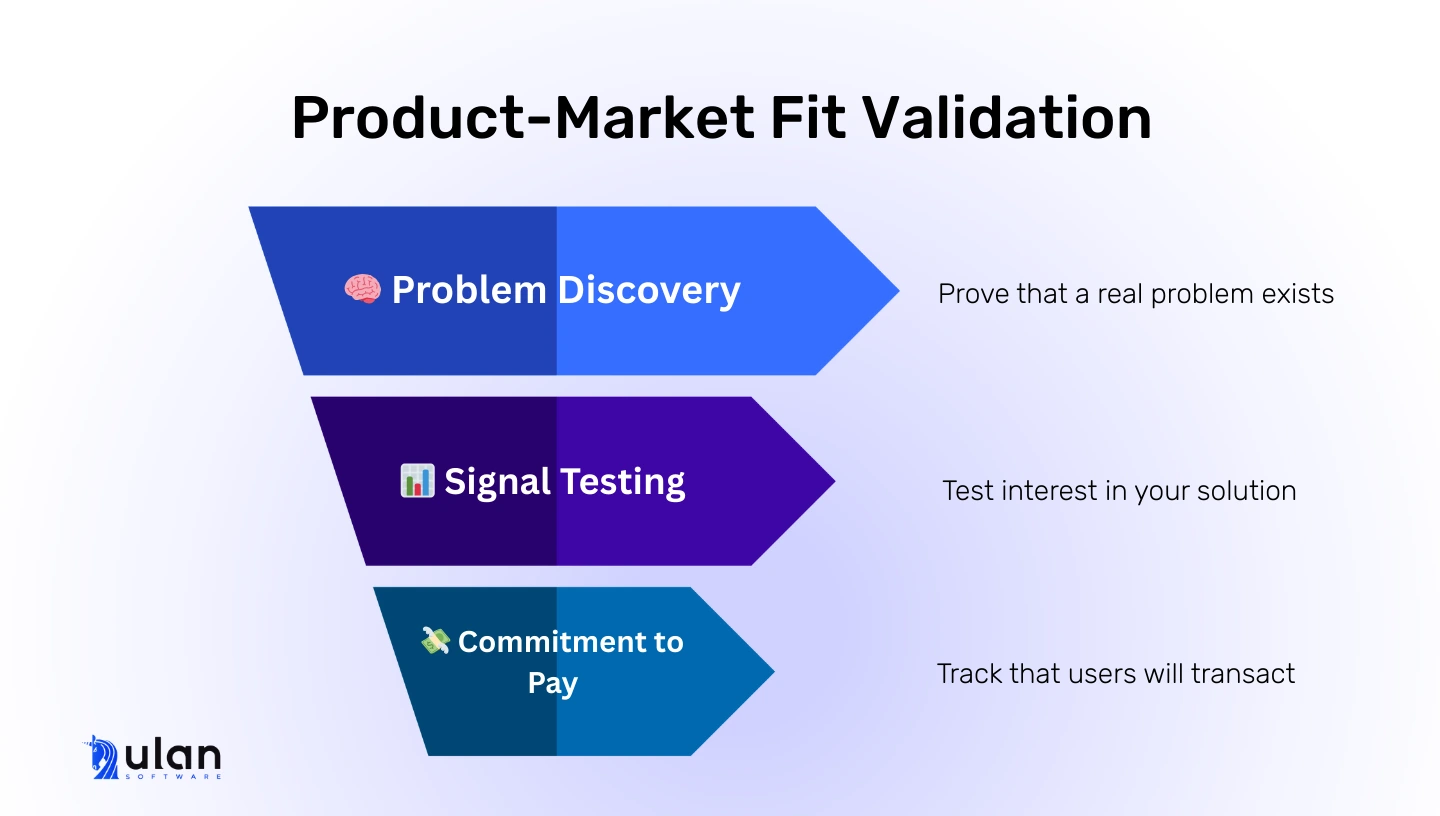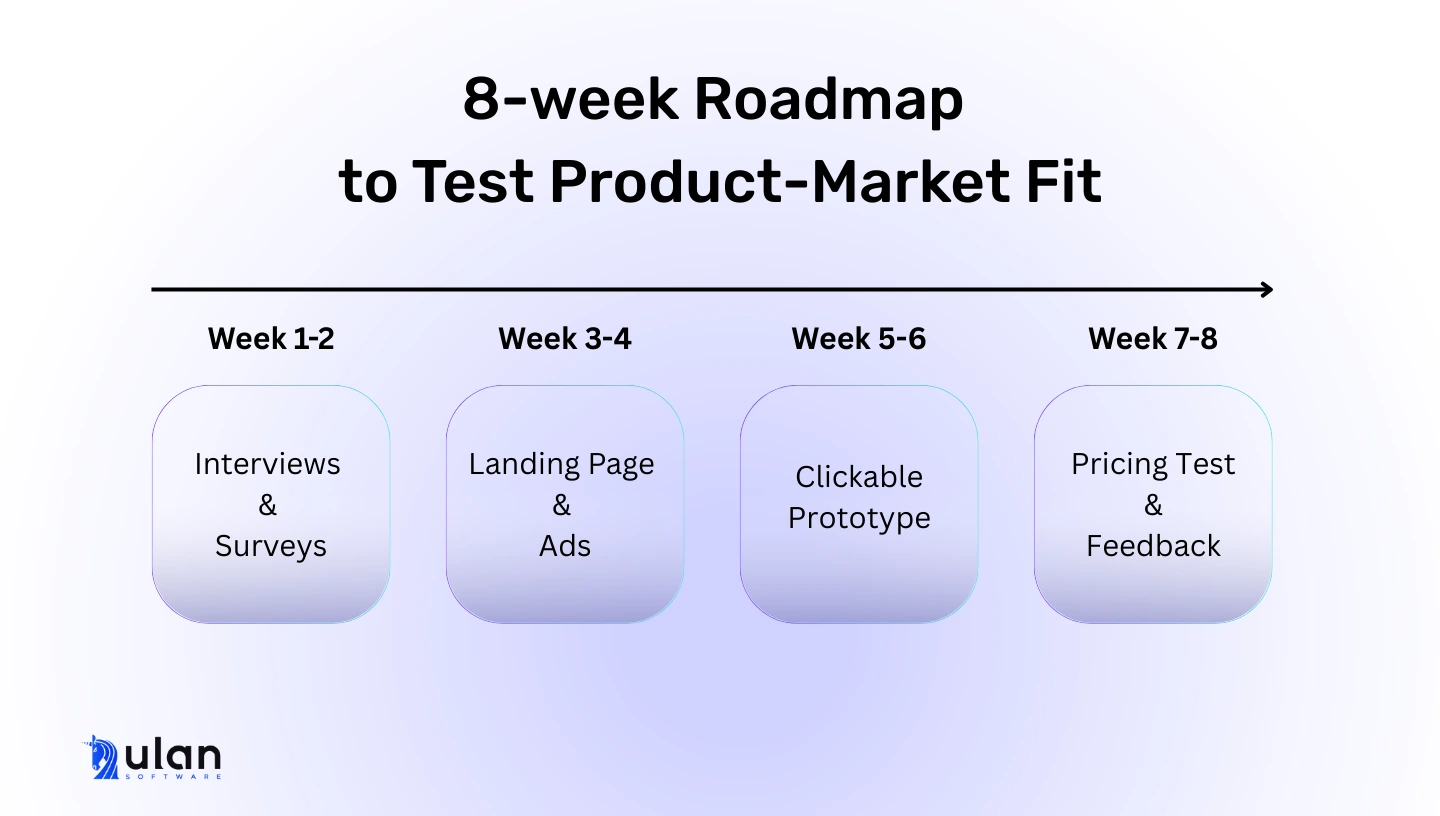Back to all Articles
Karol Andruszków
Karol is a serial entrepreneur who has successfully founded 4 startup companies. With over 11 years of experience in Banking, Financial, IT and eCommerce sector, Karol has provided expert advice to more than 500 companies across 15 countries, including Poland, the USA, the UK, and Portugal.
15 Ways to Test Product-Market Fit
Updated:
Mon, May 12
Czas czytania: 11 minut

Product-market fit means you’re solving a real problem for a real group of people, and they’re willing to pay for it. Without it, your marketplace idea is only a guess.
Marketplaces are especially tricky. You need to attract both supply and demand at the same time. If one side doesn’t show up, the whole model fails. That’s why validation is not optional. It’s your cheapest insurance against building something no one needs.
This guide shares 15 practical ways to test if your marketplace idea can gain traction. Each method helps you gather evidence, reduce risk, and spot red flags early, before you write a line of code.
Here’s the full list:
Each of these tactics can be a chapter in your validation story.
👉 If you’re still shaping your concept, start with this guide on how to validate a marketplace idea before you build.
Not all will apply to every business, but most marketplace founders will use a combination.
For example, you might start with problem interviews, then run a survey to quantify patterns.
You could build a simple landing page, drive traffic with ads, and follow up with a clickable prototype.
Marketplaces are especially tricky. You need to attract both supply and demand at the same time. If one side doesn’t show up, the whole model fails. That’s why validation is not optional. It’s your cheapest insurance against building something no one needs.
This guide shares 15 practical ways to test if your marketplace idea can gain traction. Each method helps you gather evidence, reduce risk, and spot red flags early, before you write a line of code.
15 Techniques for Product Market Fit Validation
Below, we’ll walk you through each technique in detail. You’ll learn how it works, where it fits in the journey, and how real founders used it to validate their marketplace ideas.Here’s the full list:
- Start With Problem Interviews
- Offer Pre-Orders or Sign-Up Deposits
- Test With a Landing Page and Email Capture
- Run Ad Campaigns to Test Sign-Ups
- Share with Communities
- Be the First Supplier (or Customer)
- Use Manual Matching
- Build a Community Before the Product
- Collect Letters of Intent (for B2B Validation)
- Run a Small-Scale Local Pilot
- Piggyback on Existing Platforms
- Use Surveys
- Test a Clickable Prototype with Users
- Measure Search Volume and Run SEO Tests
- Test Pricing and Willingness to Pay
Each of these tactics can be a chapter in your validation story.
👉 If you’re still shaping your concept, start with this guide on how to validate a marketplace idea before you build.
Not all will apply to every business, but most marketplace founders will use a combination.
For example, you might start with problem interviews, then run a survey to quantify patterns.
You could build a simple landing page, drive traffic with ads, and follow up with a clickable prototype.

1. Start With Problem Interviews
Talk to people, not users. Problem interviews help you test those assumptions early, before you build.
Pick 5–10 people who match your target supply and demand. Ask open questions about their current workflow, frustrations, and workarounds. Don’t pitch your idea. Just listen. The goal is to reveal real problems they already face, not problems you think they have.
Look at TaskRabbit. Before building anything, the founders interviewed busy professionals. They didn’t sell a concept. They just asked about daily stressors and challenges. For their experiment, they put an advertisement on Craigslist seeking people to help them try out their idea.
The recurring theme? No time to run errands. That insight validated a real pain point and justified building a runner service.
These interviews give you clues about urgency, frequency, and willingness to pay. If the pain is vague or low-stakes, that’s a signal too. Keep digging or rethink the problem.
Pick 5–10 people who match your target supply and demand. Ask open questions about their current workflow, frustrations, and workarounds. Don’t pitch your idea. Just listen. The goal is to reveal real problems they already face, not problems you think they have.
Look at TaskRabbit. Before building anything, the founders interviewed busy professionals. They didn’t sell a concept. They just asked about daily stressors and challenges. For their experiment, they put an advertisement on Craigslist seeking people to help them try out their idea.
The recurring theme? No time to run errands. That insight validated a real pain point and justified building a runner service.
These interviews give you clues about urgency, frequency, and willingness to pay. If the pain is vague or low-stakes, that’s a signal too. Keep digging or rethink the problem.
2. Offer Pre-Orders or Sign-Up Deposits
Interest is cheap. Money isn’t. Asking people to pay, even a small amount, helps you measure real intent.
This doesn’t mean you need a finished product. Pre-orders or deposits test whether users or suppliers believe in your solution enough to commit early. If they hesitate, it’s often because the value isn’t clear.
Kickstarter is a good example. It’s a marketplace where ideas are validated through funding. Creators don’t guess what people want, they find out through promises.
On a smaller scale, startup WeddingSpot validated their venue marketplace by asking wedding venues to pay a small fee to join before launch. This proved supplier interest and gave the team a green light to build.
This doesn’t mean you need a finished product. Pre-orders or deposits test whether users or suppliers believe in your solution enough to commit early. If they hesitate, it’s often because the value isn’t clear.
Kickstarter is a good example. It’s a marketplace where ideas are validated through funding. Creators don’t guess what people want, they find out through promises.
On a smaller scale, startup WeddingSpot validated their venue marketplace by asking wedding venues to pay a small fee to join before launch. This proved supplier interest and gave the team a green light to build.
3. Test With a Landing Page
Build a simple “coming soon” page. Describe your marketplace idea in plain language. Make the benefit clear. Add a call-to-action and an email sign-up form. Then send some traffic and measure who signs up.
You’re not testing copy here. You’re testing interest. A high conversion rate means your message is landing. A low one means either the idea, the audience, or the wording needs work.
Dropbox used this approach. Before writing any code, they launched a page with a demo video. That one page earned them 75,000 email sign-ups.
Lexoo, a legal services marketplace, did something similar. They launched a one-page site asking businesses to submit legal project requests. That simple test validated the need before building the full platform.
You’re not testing copy here. You’re testing interest. A high conversion rate means your message is landing. A low one means either the idea, the audience, or the wording needs work.
Dropbox used this approach. Before writing any code, they launched a page with a demo video. That one page earned them 75,000 email sign-ups.
Lexoo, a legal services marketplace, did something similar. They launched a one-page site asking businesses to submit legal project requests. That simple test validated the need before building the full platform.
4. Run Ad Campaigns to Test Sign-Ups
Don’t wait for organic traffic. On average, SEO takes 6 months to start seeing results.
Use paid ads to test demand fast. Platforms like Google and Facebook let you target specific groups with specific messages. Point the traffic to your landing page and see who clicks, signs up, or shows interest.
Even a small ad budget can reveal a lot. You can test which message works, which audience reacts, and whether people care enough to take action.
In the early days, founder Nick Swinmurn of Zappos didn’t buy inventory. He listed shoes online and only purchased them from local stores when someone placed an order. It wasn’t scalable, but it proved one thing: people were willing to buy shoes online. That was all the validation he needed to move forward.
Use paid ads to test demand fast. Platforms like Google and Facebook let you target specific groups with specific messages. Point the traffic to your landing page and see who clicks, signs up, or shows interest.
Even a small ad budget can reveal a lot. You can test which message works, which audience reacts, and whether people care enough to take action.
In the early days, founder Nick Swinmurn of Zappos didn’t buy inventory. He listed shoes online and only purchased them from local stores when someone placed an order. It wasn’t scalable, but it proved one thing: people were willing to buy shoes online. That was all the validation he needed to move forward.
5. Share with Communities
Go where your audience already talks. Share your idea in a forum, subreddit, or Facebook group. Describe the problem and ask for honest feedback. You’ll quickly learn if your idea clicks or falls.
One founder building a freelancer marketplace posted in a Reddit thread for freelancers. They shared the concept and invited thoughts. The result? Real feedback, early sign-ups, and direct messages from interested users.
Another example: someone testing a babysitting-on-demand service ran a poll in a parenting group. “Would you use a service to get vetted babysitters fast?” Most people said yes.
That response gave them the confidence to take the next step.
These channels are free, fast, and full of insight.
One founder building a freelancer marketplace posted in a Reddit thread for freelancers. They shared the concept and invited thoughts. The result? Real feedback, early sign-ups, and direct messages from interested users.
Another example: someone testing a babysitting-on-demand service ran a poll in a parenting group. “Would you use a service to get vetted babysitters fast?” Most people said yes.
That response gave them the confidence to take the next step.
These channels are free, fast, and full of insight.
6. Be the First Supplier (or Customer)
In a two-sided marketplace, one side often moves slower. To kick things off, play that role yourself. It’s not scalable but that’s the point. You’re proving there’s demand (or supply) by stepping in and making the exchange possible.
Airbnb’s Brian Chesky was the first host. He rented out his own apartment to early guests to show the idea could work.
Travis Kalanick from Uber drove passengers himself in the early days. He did this to understand drivers’ pain points firsthand.
Reddit isn’t a marketplace, but the same logic applies. The founders posted tons of content themselves to simulate an active community. That early momentum helped attract real users.
Airbnb’s Brian Chesky was the first host. He rented out his own apartment to early guests to show the idea could work.
Travis Kalanick from Uber drove passengers himself in the early days. He did this to understand drivers’ pain points firsthand.
Reddit isn’t a marketplace, but the same logic applies. The founders posted tons of content themselves to simulate an active community. That early momentum helped attract real users.
7. Use Manual Matching
This method lets you test demand without building full infrastructure. Users think they’re using a polished product, but behind the scenes, you’re doing the work by hand.
Magic, a YC-backed startup, launched with nothing more than a phone number. Users could text any request: order food, book a flight, find a handyman. Behind the scenes, real people fulfilled the requests. There was no app, no AI. Only humans pretending there was a system. And it worked. People loved the experience. That was all the validation they needed to invest in building tech.
In a marketplace, this could mean letting users submit a request through a form or email. Then you manually match them with someone on the other side. You get real feedback and learn what people actually want.
Magic, a YC-backed startup, launched with nothing more than a phone number. Users could text any request: order food, book a flight, find a handyman. Behind the scenes, real people fulfilled the requests. There was no app, no AI. Only humans pretending there was a system. And it worked. People loved the experience. That was all the validation they needed to invest in building tech.
In a marketplace, this could mean letting users submit a request through a form or email. Then you manually match them with someone on the other side. You get real feedback and learn what people actually want.
8. Build a Community Before the Product
Sometimes the best way to validate a marketplace is to build the audience first. Create a space where both sides of the market can connect, share problems, or trade advice. If people show up and engage, you’ve got early validation.
Hipcamp did this well. Before building their campground marketplace, they focused on content and community. They gathered camping enthusiasts and landowners through blog posts and events. When they finally launched the platform, they didn’t have to find users, they already had them.
Do the same. Start a Slack group, a LinkedIn community, or a local Meetup. Community-first approaches take time, but give you real users to learn from.
Hipcamp did this well. Before building their campground marketplace, they focused on content and community. They gathered camping enthusiasts and landowners through blog posts and events. When they finally launched the platform, they didn’t have to find users, they already had them.
Do the same. Start a Slack group, a LinkedIn community, or a local Meetup. Community-first approaches take time, but give you real users to learn from.
9. Collect Letters of Intent
In B2B marketplaces, relationships matter. Businesses move slower and "sales cycle" can last for months. That’s why a letter of intent (LOI) can be a strong validation tool, even if it’s non-binding.
An LOI says, “If you build this with these features, we plan to use it.” It’s not a contract, but it shows serious interest. It proves the pain point is real — and that someone’s willing to try your solution.
Handshake, a B2B wholesale marketplace, used this approach early on. They spoke with boutique retailers, pitched the concept, and got LOIs confirming they would use the platform if it launched with specific capabilities. That gave them the confidence (and investor backing) to build.
An LOI says, “If you build this with these features, we plan to use it.” It’s not a contract, but it shows serious interest. It proves the pain point is real — and that someone’s willing to try your solution.
Handshake, a B2B wholesale marketplace, used this approach early on. They spoke with boutique retailers, pitched the concept, and got LOIs confirming they would use the platform if it launched with specific capabilities. That gave them the confidence (and investor backing) to build.
10. Run a Small-Scale Local Pilot
Start small, even hyperlocal. Pick one city, neighborhood, or market segment and go all in. Focus on delivering a great experience, even if it means doing things that don’t scale. Your goal is to prove the model works in one place before expanding.
Instacart launched only in the Bay Area. The founder personally delivered groceries in the early days to keep the service reliable.
Deliveroo did the same. They've started in a single London neighborhood. The team signed up restaurants manually and even handled deliveries themselves to make sure nothing failed.
This approach keeps feedback loops short. And if it works locally, it’s a strong signal that the model can be replicated elsewhere.
Instacart launched only in the Bay Area. The founder personally delivered groceries in the early days to keep the service reliable.
Deliveroo did the same. They've started in a single London neighborhood. The team signed up restaurants manually and even handled deliveries themselves to make sure nothing failed.
This approach keeps feedback loops short. And if it works locally, it’s a strong signal that the model can be replicated elsewhere.
11. Piggyback on Existing Platforms
Before you build your own marketplace, try validating demand on platforms that already exist. Think of it as a free sandbox. If you can’t get traction there, it’s a problem.
If you’re testing a niche product marketplace, list items on Etsy, Amazon, or eBay. Watch what sells, who buys, and how they respond. If you're building a ride-share idea, try posting in Facebook groups or Craigslist to see if riders and drivers engage.
Many indie marketplace founders take this route. It's faster, cheaper, and gives you real customer signals without writing a line of code.
If you’re testing a niche product marketplace, list items on Etsy, Amazon, or eBay. Watch what sells, who buys, and how they respond. If you're building a ride-share idea, try posting in Facebook groups or Craigslist to see if riders and drivers engage.
Many indie marketplace founders take this route. It's faster, cheaper, and gives you real customer signals without writing a line of code.
12. Use Surveys
Surveys can help you reach more people, fast. But take the results with caution. Unlike interviews, surveys lack depth. People say what they might do, not what they’ll actually do.
That said, when planned and used well, surveys can still validate early interest. Focus on scenario-based questions like:
“If a service existed that did X, how likely are you to use it?”
“What would you expect to pay for it?”
“How do you currently solve this problem?”
Indie Hackers users often post surveys on forums or Twitter to test startup ideas.
That said, when planned and used well, surveys can still validate early interest. Focus on scenario-based questions like:
“If a service existed that did X, how likely are you to use it?”
“What would you expect to pay for it?”
“How do you currently solve this problem?”
Indie Hackers users often post surveys on forums or Twitter to test startup ideas.
13. Test a Clickable Prototype with Users
A prototype lets you show, not just tell. Tools like Figma or Adobe XD make it easy to create a realistic mockup of your marketplace flow.
Walk a few target users through the prototype. Ask them to complete common tasks like posting a job, booking a service, or making a payment. Watch where they hesitate, get confused, or ask questions. Their reactions will show you whether your design makes sense and whether the core idea solves a real problem.
Walk a few target users through the prototype. Ask them to complete common tasks like posting a job, booking a service, or making a payment. Watch where they hesitate, get confused, or ask questions. Their reactions will show you whether your design makes sense and whether the core idea solves a real problem.

14. Measure Search Volume and Run SEO Tests
Search data shows what people already want. Use keyword tools like Google Keyword Planner, Ahrefs, or Ubersuggest to see how often people search for problems your marketplace solves.
But don’t only look at numbers, analyze the intent.
Keyword intent refers to why someone is searching. Are they looking to buy, compare options, or just browse?
High-intent keywords show clear buying signals: “hire vegan caterer,” “book local handyman,” “buy used camera near me.”
Low, informational intent might be broader: “vegan food ideas” or “how to fix a leaking pipe.”
For validation, high-intent keywords are gold. They suggest people aren’t curious but are looking for a solution.
But don’t only look at numbers, analyze the intent.
Keyword intent refers to why someone is searching. Are they looking to buy, compare options, or just browse?
High-intent keywords show clear buying signals: “hire vegan caterer,” “book local handyman,” “buy used camera near me.”
Low, informational intent might be broader: “vegan food ideas” or “how to fix a leaking pipe.”
For validation, high-intent keywords are gold. They suggest people aren’t curious but are looking for a solution.
15. Test Pricing and Willingness to Pay
You need to know if people will pay for what you’re offering, and if the pricing model is sustainable.
Start small. Try different pricing options with early users.
For suppliers, test commission rates — see if a 10% cut feels fair or if a 20% rate scares them off.
For customers, test flat fees vs. tiered models. Don’t be afraid to ask for money early. It tells you more than polite interest ever will.
If you're still deciding how to charge, check out our guide on how to monetize a service marketplace.
Start small. Try different pricing options with early users.
For suppliers, test commission rates — see if a 10% cut feels fair or if a 20% rate scares them off.
For customers, test flat fees vs. tiered models. Don’t be afraid to ask for money early. It tells you more than polite interest ever will.
If you're still deciding how to charge, check out our guide on how to monetize a service marketplace.
Quantitative Benchmarks for Marketplace Validation
You don’t need perfect metrics, but here’s what healthy early traction often looks like:
Focus on signals, not perfection. These numbers help you know if you're moving in the right direction.
If you're ready to move beyond validation and start building, explore our online marketplace development services to launch faster with the right architecture from day one.
- Landing page sign-ups: Over 10% conversion from visitors shows strong interest. Under 5%? Your message or targeting might be off.
- Waitlist size: A few hundred sign-ups for a niche idea, or a few thousand for broader consumer apps, is a good sign, without big ad spend.
- Supply & demand matching: At least 20–30% of your listed supply should get some demand within the first few weeks. Low match rates usually mean not enough demand or the wrong supply.
- User requests getting fulfilled: Try to have a response or result for 70–80% of user actions — whether that’s a search, booking request, or message.
Focus on signals, not perfection. These numbers help you know if you're moving in the right direction.
If you're ready to move beyond validation and start building, explore our online marketplace development services to launch faster with the right architecture from day one.
Final Thoughts
Validating product–market fit is a series of small experiments. This guide gave you 15 practical ways to do that. You don’t need to use them all, but you do need to gather real signals.
Skip validation, and you’re guessing. Run these tests, and you’re building with evidence.
If you’d like help designing or running your validation process, we offer a free consultation at Ulan Software. We’ve helped founders test marketplace ideas, run pilots, and launch MVPs faster (with less guesswork). Let's Talk!
Skip validation, and you’re guessing. Run these tests, and you’re building with evidence.
If you’d like help designing or running your validation process, we offer a free consultation at Ulan Software. We’ve helped founders test marketplace ideas, run pilots, and launch MVPs faster (with less guesswork). Let's Talk!
Karol Andruszków
Karol is a serial entrepreneur who has successfully founded 4 startup companies. With over 11 years of experience in Banking, Financial, IT and eCommerce sector, Karol has provided expert advice to more than 500 companies across 15 countries, including Poland, the USA, the UK, and Portugal.
Table of Contents:
Thinking of launching a marketplace?
Let’s validate your idea the right way
Let’s validate your idea the right way
Let’s Talk!
Contact Us!
Recommended Articles
Tue, Nov 25
How to Choose the Best Marketplace Software?
Learn how to choose the best marketplace software with a clear, step-by-step guide. Compare models, features, scale, cost, and vendor fit to make a confident choice.
Thu, Nov 20
Top 15 UX Tips to Improve Conversion Rates in Travel Booking
Improve travel booking flow conversion with 15 proven UX tips. Learn how mobile design, pricing clarity, speed, and smart flows reduce friction and lift bookings.
Mon, Nov 17
What to Look for in Enterprise Booking Software?
Learn what to look for in enterprise booking software: key features, integrations, security, and data to guide your 2025 selection.


